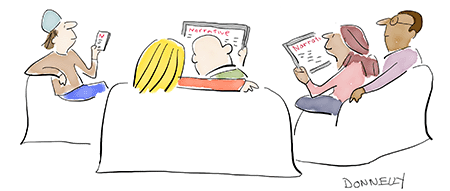The pigeons are not to be named. They are research subjects, not pets. We assign them a series of letters and numerals generated by an algorithm. That’s what our research protocol requires.
I have occasionally found notes stuffed in a drawer or under a notebook: “Petunia was aggressive today,” “Ruffles favors her left wing,” “Angel wants to fly.” Penny told me they were just random thoughts jotted down for her Roller Derby blog—Petunia, Ruffles, and Angel were members of the team she followed, she said. Fifteen years caring for the pigeons and pitching in where needed, while graduate students cycled in and out, merited some latitude, I suppose. Plus, the pigeons liked her.
As research subjects, pigeons exhibit abilities that surprise the average person. They can be taught to discriminate between a Monet and a Picasso, although they become somewhat confused when a Monet is hung upside down. Why anyone would hang a Monet upside down, I don’t know. They can be trained to distinguish Bach from Stravinsky, with a preference for Bach. They can learn the alphabet—Latin-based, that is—and some can be taught to recognize multiple four-letter words—not profanity, but words with four letters like rule, don’t, name, pets.
In our lab we’ve trained the birds to distinguish between benign and malignant histopathology in slides of biopsied breast tissue. The same traits that let pigeons see patterns in art, music, and writing let them pick out cancerous lesions from noncancerous ones. They decode the images on monitors in darkened operant conditioning chambers—heads bobbing, shifting from one foot to another, like anxious jurors deliberating all by themselves, recognizing their verdict will mean gentle mercy for some women, fear and woe for others.
Their accuracy rate matches that of most pathologists.



